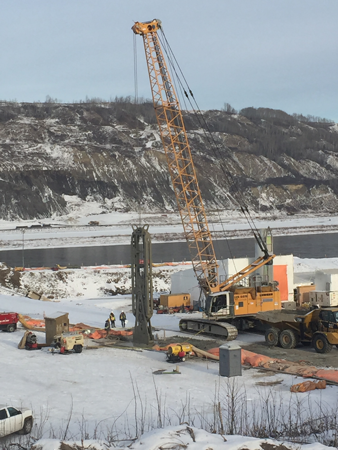SITE C (Canada)
Foundation Works Executed by BAUER Foundations Canada Inc.
The objective of this dam is the creation of a third hydro-electric power plant on the Peace River in northeast British Columbia (B.C.). B.C. is the westernmost province in Canada, located between the Rocky Mountains and the Pacific Ocean. The dam will be a source of clean, renewable and affordable electricity in B.C. It will provide 1,100 megawatts (MW) of capacity, and produce about 5,100 gigawatt hours (GWh) of electricity each year – enough energy to power the equivalent of about 450,000 homes per year in B.C.
The site of SITE C project is located in the northeastern part of British Columbia, seven kilometers southwest of Fort St. John. Located at Mile 47, Fort St. John is one of the largest cities along the Alaska Highway. Originally established in 1794, as a trading post, Fort St. John is the oldest European-established settlement in present-day British Columbia.
The Peace River is a 1,923 km-long river that originates in the Rocky Mountains of northern British Columbia and flows to the northeast through northern Alberta. The Peace River joins the Athabasca River in the Peace-Athabasca Delta to form the Slave River, a tributary of the Mackenzie River. The Finlay River, the main headwater of the Peace River, is regarded as the ultimate source of the Mackenzie River. The combined Finlay–Peace–Slave–Mackenzie river system is the 13th longest river system in the world.
The development includes the constructing two temporary cofferdams and diversion tunnels; the building an 800-metre-long roller-compacted-concrete buttress; the constructing an earthfill dam approximately 1,050 meters long and 60 meters high above the riverbed; the building a generating station and the installing six 183 MW generating units.
Client: British Columbia Hydro and Power Authority (BC Hydro)
Employer: Peace River Hydro Partners (Acciona Infrastructure Canada Inc., Samsung C&T Canada Ltd. and Petrowest Corporation)
Execution: BAUER Foundations Canada Inc.
The installed single phase cut-off wall provides the necessary vertical underground sealing The cut-off walls Bauer's scope of work comprised the installation of four cement bentonite cut-off walls at various locations along the new proposed dam.
Approximately 80,000 m² cut-off wall with a nominal thickness of 0,6 m and a maximum of 1.8 m was completed in November 2017 which included a maximum rock embedment of 3.8 m into weak sandstone / mudstone in order to reach the designed cut-off wall toe levels.
The average excavation depth was 21 m with the maximum depth reaching up to 25 m.
Geology:
- dike fill material (thickness between 4 to 6 m with a grain size of 3 inch down) and
- heterogeneous soil condition: clay, silt, sand, gravel and cobbles, weak sandstone and mudstone.
The works were executed by utilizing up to three excavation units (both hydraulic and rope grabs).
In order to meet the specified construction schedule, the cut-off wall works had to be executed through the winter months facing the harsh winter conditions of Northern Canada. Temperatures during wall installation were as low as - 25° Celsius (lower than -30° Celsius when considering the wind chill) and this has required a special winterization set-up for the mixing plants as well as the slurry lines.
The cut-off wall construction works were carried out between August 2016 to November 2017 working continuously 24 hrs. per day, 4 days per week.






